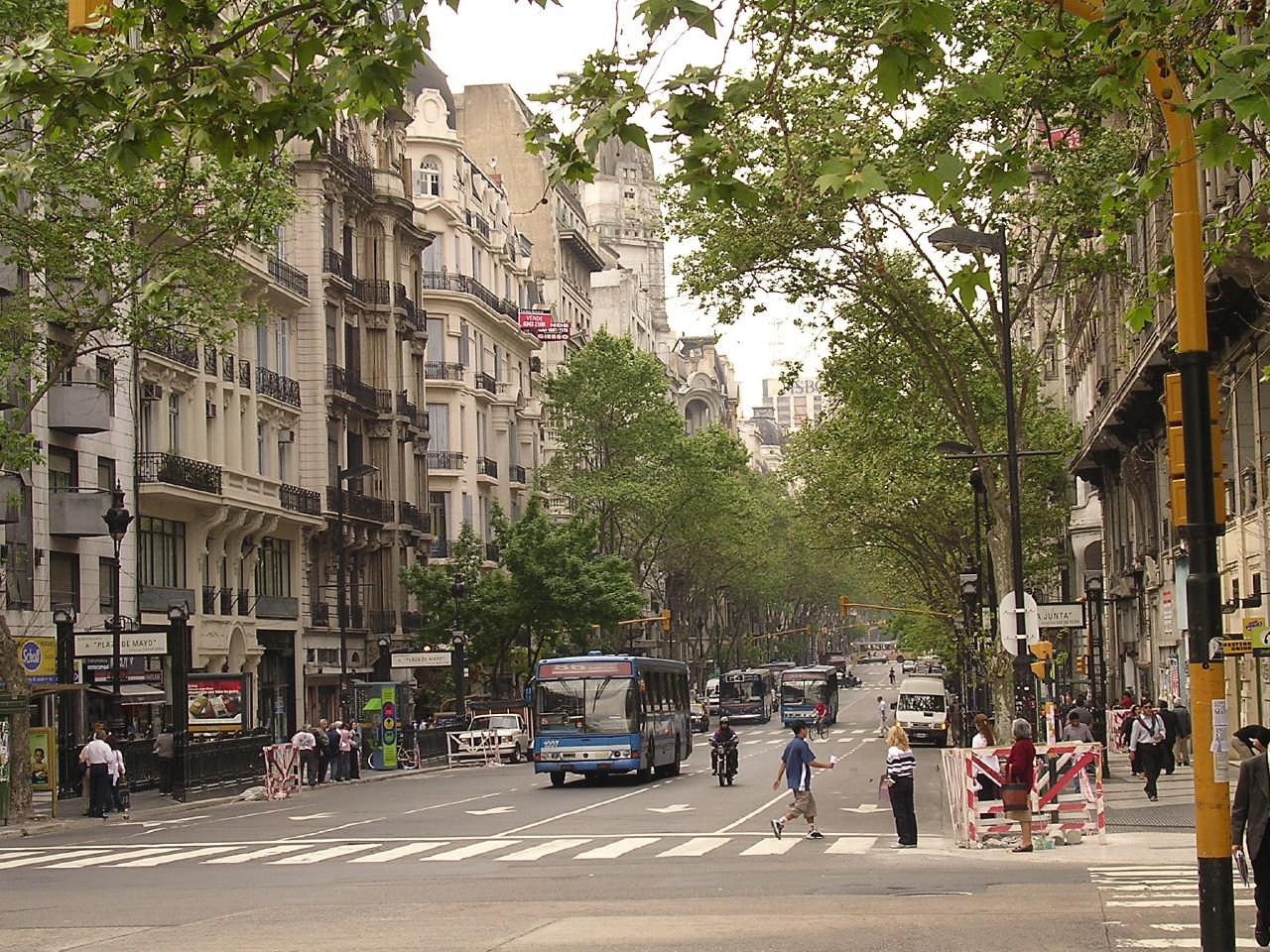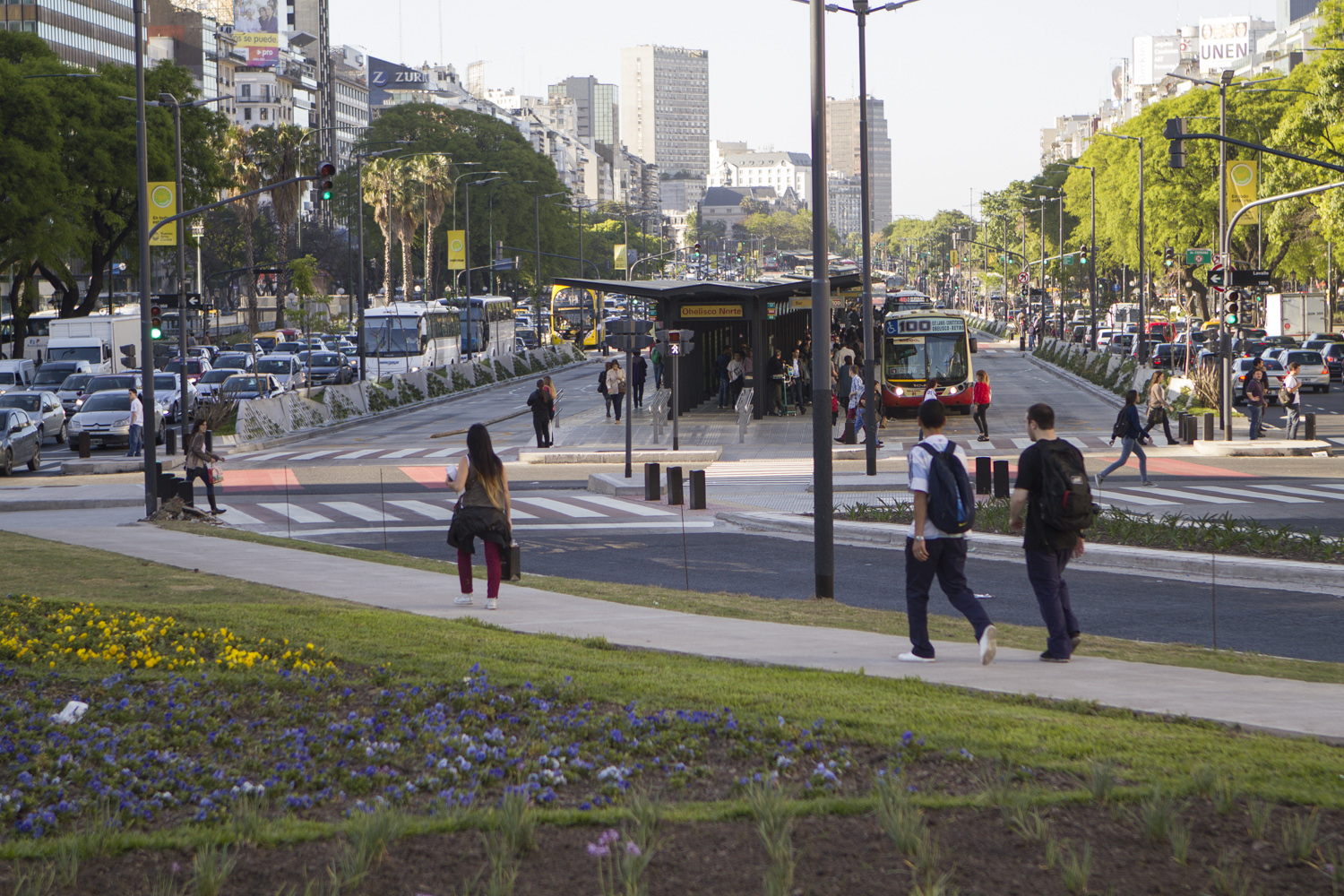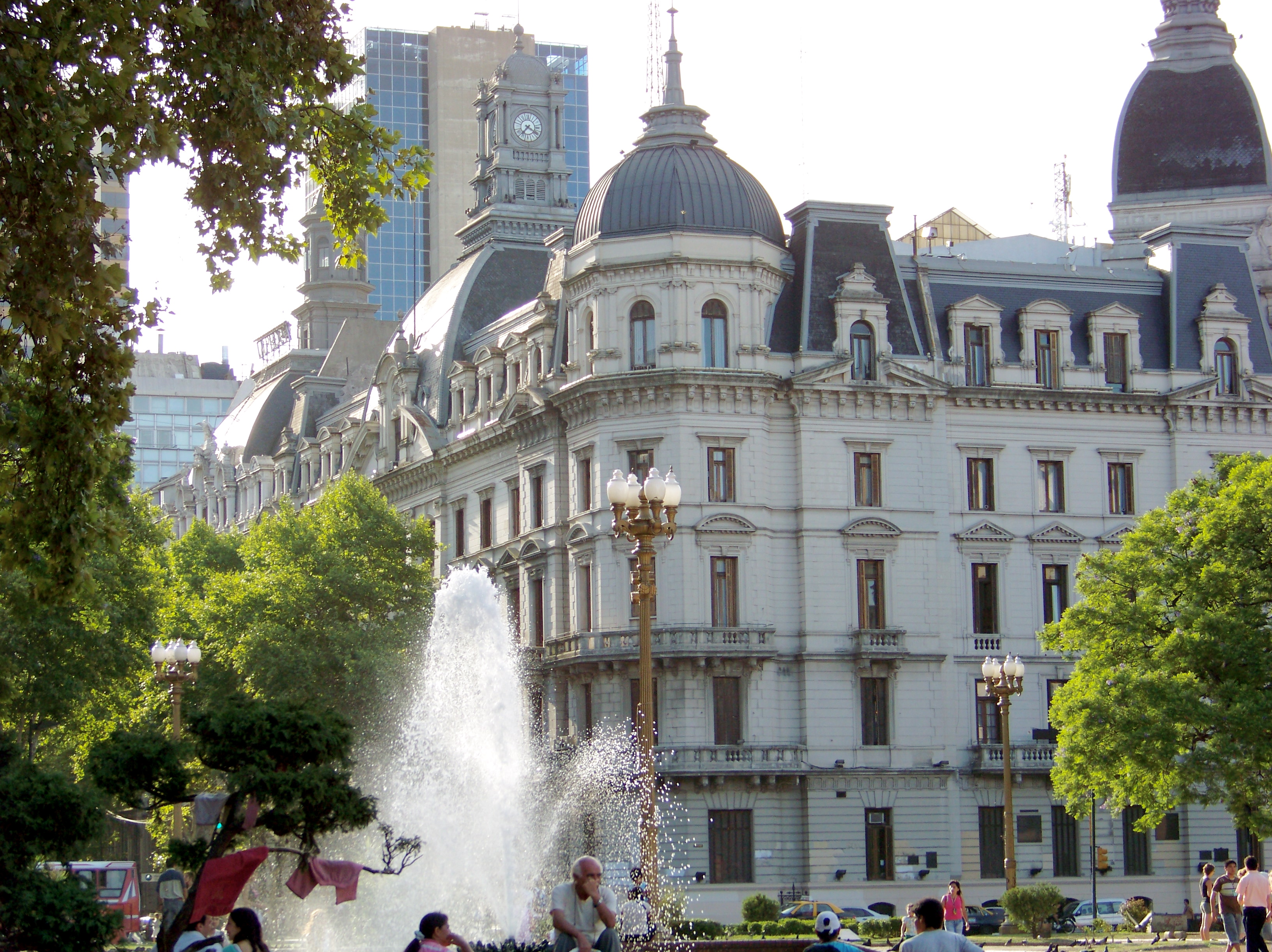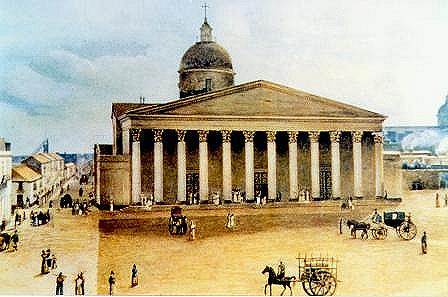|
Avenida Rivadavia
Avenida Rivadavia is one of the principal thoroughfares in Buenos Aires, Argentina, extending from downtown Buenos Aires to the western suburb of Merlo. History Upon the designation of the Viceroyalty of the Río de la Plata by the Spanish Empire in 1776, the "Road of the Kingdom of Heaven" leading into Buenos Aires from the east was designated a ''Camino Real'', a "Royal Road" fit for a Viceroy, and afforded improvements and some security. This Royal Road of the West, by 1782, traveled to Mendoza, a city over to the west (roughly along the modern National Highway 7). Dubbed Federation Road by the paramount Governor Juan Manuel de Rosas in 1836, it was renamed in honor of former President Bernardino Rivadavia in 1857, following the reestablishment of constitutional rule. The Buenos Aires Metro, inaugurated in 1913, was extended to Rivadavia Avenue in 1926, whereby 11 of the 16 stations on line were built underneath the avenue. Rivadavia was on Buenos Aires' first bus ... [...More Info...] [...Related Items...] OR: [Wikipedia] [Google] [Baidu] |
Rivadavia Looking East
Rivadavia may refer to: Places Argentina Populated places * Comodoro Rivadavia (Chubut) * Rivadavia, Salta (Salta) * Rivadavia, San Juan (San Juan) * Rivadavia, Mendoza (Mendoza) Departments * Rivadavia Department (other) other * Rivadavia Avenue (one of Buenos Aires' most important thoroughfares) * (Argentina's first and only class of dreadnought battleship) * , the first of its class, at the time of its 1911 launch, the world's largest battleship * Lake Rivadavia, in Los Alerces National Park * Club Rivadavia, Argentine football club from Lincoln, Buenos Aires Lincoln is a city in the province of Buenos Aires in Argentina. It is the capital of the district of Lincoln (Lincoln Partido). The district of Lincoln was established on July 19, 1865, during a redistricting of Buenos Aires Province. The first ... People * Bernardino Rivadavia (the first president of Argentina) {{disambiguation, geo, surname ... [...More Info...] [...Related Items...] OR: [Wikipedia] [Google] [Baidu] |
Luján, Buenos Aires
Luján (pronounced ) is a city in the Buenos Aires province of Argentina, located 68 kilometres north west of the city of Buenos Aires. The city was founded in 1755 and has a population of 106,899 (per the ). Luján is best known for its large neo-gothic Basilica, built in honor of the Virgin of Luján, the patron saint of Argentina. Every year, more than six million people make pilgrimages to the basilica, many walking there from Buenos Aires. The city is known as ''La Capital de la Fe'' (Capital of the Faith). It is popular day-trip for non-believers too, with abundant grill restaurants (like most places in Argentina) and souvenir shops with kitsch religious memorabilia. The church was designed by the French architect Ulderico Courtois and started in 1889, completed by 1937. Its towers stand 106m high and it has a copper roof and bronze doors. The huge church towers over the surrounding flat country and houses the tiny 38 cm high statue of the Virgin. A large and im ... [...More Info...] [...Related Items...] OR: [Wikipedia] [Google] [Baidu] |
Argentine Congress
The Congress of the Argentine Nation ( es, Congreso de la Nación Argentina) is the legislative branch of the government of Argentina. Its composition is bicameral, constituted by a 72-seat Senate and a 257-seat Chamber of Deputies. The Senate, whose members are elected to six-year terms renewable by thirds each two years, consists of three representatives from each province and the federal capital. The Chamber of Deputies, whose members are elected to four-year terms, is apportioned according to population, and renews their members by a half each two years. The Congressional Palace is located in Buenos Aires, at the western end of Avenida de Mayo (at the other end of which is located the Casa Rosada). The ''Kilometre Zero'' for all Argentine National Highways is marked on a milestone at the Congressional Plaza, next to the building. Attributes The Argentine National Congress is bicameral, composed of the Senate and the Chamber of Deputies. The ordinary sessions span is from M ... [...More Info...] [...Related Items...] OR: [Wikipedia] [Google] [Baidu] |
Congressional Plaza
Congressional Plaza (Spanish language, Spanish: ''Plaza del Congreso'') is a public park facing the Argentine Congress in Buenos Aires. The plaza is part of a 3 hectare (7.5 acre) open space comprising three adjoining plazas to the east of the Congress building. The ''Kilometre Zero'' for all Transportation in Argentina#Road transport, Argentine National Highways is marked on a milestone at the Plaza. History Colonial-era businessman Pedro Lorea purchased a 2 hectare (5 acre) lot in the Piety Market Hollow west of the growing hamlet of Buenos Aires in 1782. Lorea later donated around a third of this property for a carriage and cart stop. The Lorea matrimony lost their lives during the failed 1807 British invasions of the Río de la Plata and, in 1808, Viceroy Rafael de Sobremonte renamed the carriage lot in their honor. Plaza Lorea retained this function until 1871, when the swamps west of it were drained for development. A flour mill and wholesale market opened in the surroun ... [...More Info...] [...Related Items...] OR: [Wikipedia] [Google] [Baidu] |
Avenida De Mayo
May Avenue ( es, Avenida de Mayo) is an avenue in Buenos Aires, capital of Argentina. It connects the Plaza de Mayo with Congressional Plaza, and extends in a west–east direction before merging into Rivadavia Avenue. History and overview Built on an initiative by Mayor Torcuato de Alvear, work began in 1885 and was completed in 1894. The avenue is often compared with ''La Gran Vía'' in Madrid, although the Spanish avenue was built later (1910). It is also compared to those in Paris or Barcelona due to its sophisticated buildings of art nouveau, neoclassic and eclectic styles. The avenue was named in honor of the May Revolution of 1810 (the event that led to Argentine Independence). The site of the assembly that touched off the revolution (the Buenos Aires Cabildo) was partially demolished in 1888 to make way for the avenue's entry into Plaza de Mayo. The avenue's layout, built through existing urban blocks instead of via the widening of a parallel street, was desig ... [...More Info...] [...Related Items...] OR: [Wikipedia] [Google] [Baidu] |
Avenida 9 De Julio
July 9 Avenue (Spanish: ''Avenida 9 de Julio'') is a major thoroughfare in the city centre of Buenos Aires, Argentina. Its name honors Argentina's Independence Day, July 9, 1816. The avenue runs around to the west of the Río de la Plata waterfront, from the Retiro district in the north to Constitución station in the south. The avenue has up to seven lanes in each direction and is flanked on either side by parallel streets of two lanes each. Through the centre of the avenue runs one of the city's Metrobus (Bus rapid transit) corridors, which stretches and was inaugurated in July 2013. There are two wide medians between the side streets and the main road. It is currently the widest avenue in the world. The northern end of the avenue is connected to the Arturo Illia expressway (which connects to Jorge Newbery airport and the Pan-American highway) and to Libertador avenue. The southern end is connected to the 25 de Mayo tollway (serving the west side of Greater Buenos Aires a ... [...More Info...] [...Related Items...] OR: [Wikipedia] [Google] [Baidu] |
Calle Florida
Florida Street ( es, Calle Florida) is a popular shopping street in Downtown Buenos Aires, Argentina. A pedestrian street since 1971, some stretches have been pedestrianized since 1913. The pedestrian section as such starts at the intersection of Perú Street and Avenida de Mayo, a block north of the Plaza de Mayo; Perú Street crosses Rivadavia Avenue, and becomes Florida Street. Florida Street runs northwards for approximately one kilometer to Plaza San Martín, in the Retiro area. It intersects Buenos Aires's other pedestrian street, Lavalle, at the heart of the former cinema district. Florida is one of the city's leading tourist attractions. Florida Street bustles with shoppers, vendors, and office workers alike because of its proximity to the financial district. By evening, the pace relaxes as street performers flock to the area, including tango singers and dancers, living statues, and comedy acts. Its variety of retail stores, shopping arcades, and restaurants is ... [...More Info...] [...Related Items...] OR: [Wikipedia] [Google] [Baidu] |
Buenos Aires CBD
The Buenos Aires Central Business District is the main commercial centre of Buenos Aires, Argentina, though not an official city ward. While the ''barrios'' of Puerto Madero and Retiro house important business complexes and modern high-rise architecture, the area traditionally known as ''Microcentro'' (Spanish: Microcenter) is located within San Nicolás and Monserrat, roughly coinciding with the area around the historic center of the Plaza de Mayo. The ''Microcentro'' has a wide concentration of offices, service companies and banks, and a large circulation of pedestrians on working days. Another name given to this unofficial ''barrio'' is ''La City'', which refers more precisely to an even smaller sector within the ''Microcentro'', where almost all the banking headquarters of the country are concentrated. Overview The area was the site of the first European settlement in what later became Buenos Aires. Its south–north axis runs along Leandro Alem Avenue, from Belgrano ... [...More Info...] [...Related Items...] OR: [Wikipedia] [Google] [Baidu] |
Buenos Aires City Hall
Buenos Aires City Hall ( es, Palacio Municipal de la Ciudad de Buenos Aires; lit. "Municipal Palace") was, until 2015, the seat of the Office of the Chief of Government of Buenos Aires, the capital city of Argentina. From its construction in 1914 to the reformation of the city's constitution in 1996, the building was the seat of the City Municipality. It faces the Plaza de Mayo, across from the Casa Rosada presidential palace, in the ''barrio'' of Monserrat. Since 2015, the Office of the Chief of Government has been located at a new building in the ''barrio'' of Parque Patricios. The City Hall still houses various government offices of the city government. Building The 1880 Federalization of Buenos Aires was followed by a boom in foreign trade and European immigration, and in 1890, Mayor Francisco P. Bollini commissioned the construction of a new city hall. The building would replace what had been the city government's offices since 1860 - the second floor of police headquarter ... [...More Info...] [...Related Items...] OR: [Wikipedia] [Google] [Baidu] |
Metropolitan Cathedral Of Buenos Aires
The Buenos Aires Metropolitan Cathedral ( es, Catedral Metropolitana de Buenos Aires) is the main Catholic church in Buenos Aires, Argentina. It is located in the city center, overlooking Plaza de Mayo, on the corner of San Martín and Rivadavia streets, in the San Nicolás neighbourhood. It is the mother church of the Archdiocese of Buenos Aires and the primatial church of Argentina. The Cathedral of Buenos Aires was rebuilt several times since its humble origins in the 16th century. The present building is a mix of architectural styles, with an 18th-century nave and dome and a severe, 19th-century Neoclassical façade without towers. The interior keeps precious 18th-century statues and altarpieces, as well as abundant Neo-Renaissance and Neo-Baroque decoration. History and architecture Origins During the definitive foundation of Buenos Aires by Juan de Garay in 1580, part of a block facing the main square was reserved for the major church of the town. This is st ... [...More Info...] [...Related Items...] OR: [Wikipedia] [Google] [Baidu] |
Banco De La Nación Argentina
Banco de la Nación Argentina ( en, Bank of the Argentine Nation) is a national bank in Argentina, and the largest in the country's banking sector. History The Bank of the Argentine Nation was founded on 18 October 1891 by President Carlos Pellegrini, with the purpose of stabilizing the nation's finances following the Panic of 1890; its first director was Vicente Lorenzo Casares. In its early decades it became a leading financing source for agricultural smallholders, and later for commercial and industrial businesses, as well as handling an array of public sector transactions. The bank's reputation suffered after it was revealed that bribes had been received by the board of directors in 1994 when contacting IBM for the supply of computers, software, and communication equipment, becoming a prominent political scandal at the time. Services Long a significant supplier of domestic lending in a credit-tight economy, the bank attempted—with only partial success—to revive the l ... [...More Info...] [...Related Items...] OR: [Wikipedia] [Google] [Baidu] |
Plaza De Mayo
The Plaza de Mayo (; en, May Square) is a city square and main foundational site of Buenos Aires, Argentina. It was formed in 1884 after the demolition of the Recova building, unifying the city's Plaza Mayor and Plaza de Armas, by that time known as ''Plaza de la Victoria'' and ''Plaza 25 de Mayo,'' respectively. The city centre of Buenos Aires, Plaza de Mayo has been the scene of the most momentous events in Argentine history, as well as the largest popular demonstrations in the country. On the occasion of the first anniversary of the May Revolution in 1811, the Pirámide de Mayo ( en, May Pyramid) was inaugurated in the square's hub, becoming Buenos Aires' first national monument. It is located in the financial district known as '' microcentro'', within the ''barrio'' ( en, neighborhood) of Monserrat. It is bounded by Bolívar, Hipólito Yrigoyen, Balcarce and Avenida Rivadavia streets; and from its west side three important avenues are born: Avenida Presidente Julio Arge ... [...More Info...] [...Related Items...] OR: [Wikipedia] [Google] [Baidu] |









